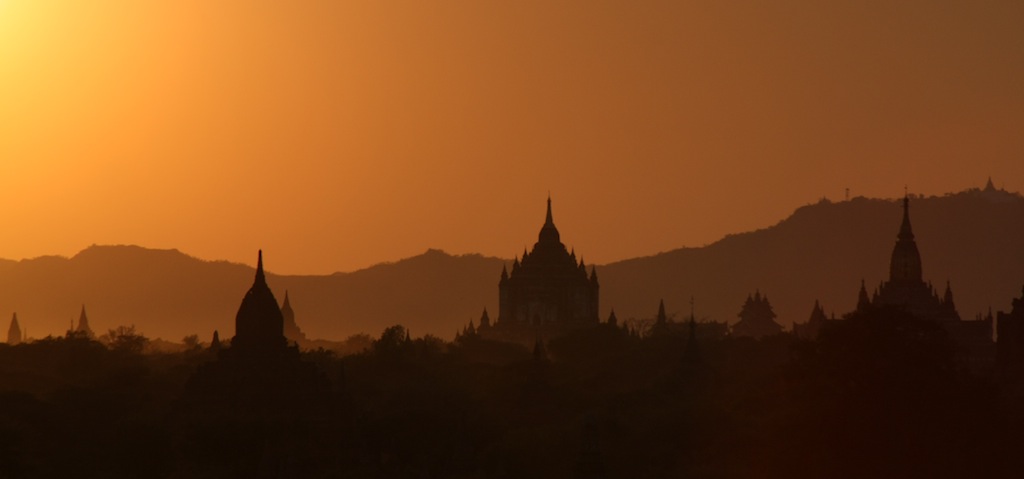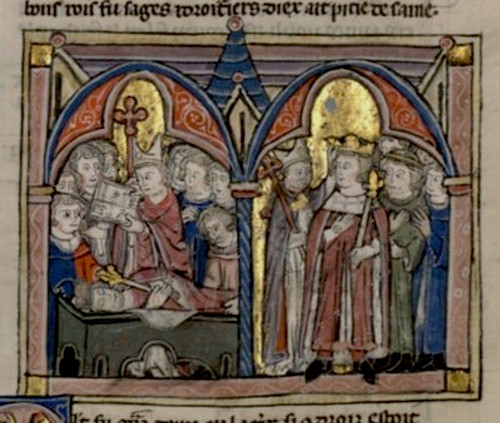|
Shin Panthagu
The Venerable Shin Panthagu ( ; 1083–c. 1174) was primate of Pagan Kingdom from 1115 to 1168. The Theravada Buddhist monk, son of the lord of Seinnyet, succeeded his teacher Shin Arahan as primate.Harvey 1925: 46 For the next five decades, he was the chief religious adviser to King Alaungsithu, and helped advise many of Alaungsithu's religious deeds. The notable works were the repairs of the Buddhagaya Temple circa 1118, and the buildings of the Thatbyinnyu Temple, and the Shwegugyi Temple. In 1168, he left Pagan (Bagan) for Ceylon in protest of Narathu who killed his father Alaungsithu and his elder brother Min Shin Saw to seize the throne. Shin Panthagu was especially disgusted by Narathu's treachery because Narathu used Panthagu in his scheme. By Narathu's urging, Shin Panthagu had gone and asked Min Shin Saw, whose troops were massed outside Pagan, to take the throne—with the explicit promise by Narathu that he would not harm Min Shin Saw. Narathu did not har ... [...More Info...] [...Related Items...] OR: [Wikipedia] [Google] [Baidu] |
Bagan
Bagan ( ; ; formerly Pagan) is an ancient city and a UNESCO World Heritage Site in the Mandalay Region of Myanmar. From the 9th to 13th centuries, the city was the capital of the Pagan Kingdom, the first kingdom that unified the regions that would later constitute Myanmar. During the kingdom's height between the 11th and 13th centuries, more than 10,000 Buddhist temples, Burmese pagoda, pagodas and Kyaung, monasteries were constructed in the Bagan plains alone, of which the remains of over 2200 temples and pagodas survive. The Bagan Archaeological Zone is a main attraction for Tourism in Myanmar, the country's nascent tourism industry. Etymology Bagan is the present-day Burmese dialects#Dialects, standard Burmese pronunciation of the Burmese word ''Pugan'' ( my-Mymr, ပုဂံ), derived from Old Burmese ''Pukam'' ( my-Mymr, ပုကမ်). Its classical Pali name is ''Arimaddanapura'' ( my-Mymr, အရိမဒ္ဒနာပူရ, lit. "the City that Tramples on Enemies ... [...More Info...] [...Related Items...] OR: [Wikipedia] [Google] [Baidu] |
Shwegugyi Temple
The Shwegugyi Temple (, ; literally, "Great Golden Cave") is a Theravadin Buddhist temple in Bagan, Myanmar. The temple is recognized as Monument #1589 in the Bagan Archeological Area, a UNESCO World Heritage Site. Located just to the southeast of what apparently were the ruins of the former royal palace founded by King Kyansittha (r. 1084–1113), the temple was built by King Sithu I of Pagan Paganism (, later 'civilian') is a term first used in the fourth century by early Christians for people in the Roman Empire who practiced polytheism, or ethnic religions other than Christianity, Judaism, and Samaritanism. In the time of the ... (Bagan) in 1131.Coedes 1968: 166 According to the stone inscriptions at the temple, set up in 1141,Dutton 2014 construction work on the temple began on 17 May 1331, and was completed on 17 December 1331.Maha Yazawin Vol. 1 2006: 199, footnote 1 Built on an expansive tall brick foundation, the temple is known for its arched windows, and fin ... [...More Info...] [...Related Items...] OR: [Wikipedia] [Google] [Baidu] |
Burmese Buddhist Monks
Burmese may refer to: * Something of, from, or related to Myanmar, a country in Southeast Asia * Burmese people * Burmese language * Burmese alphabet * Burmese cuisine * Burmese culture Animals * Burmese cat * Burmese chicken * Burmese (horse), a horse given to Queen Elizabeth II * Burmese pony, a breed of horse * Burmese python See also * * :Burmese people * Bamar people, the majority ethnic group in Myanmar * Burmese English, the dialect of English spoken in Myanmar/Burma * Bernese (other) Bernese is the adjectival form for the canton of Bern or for Bern. Bernese may also refer to: * Bernese German Bernese German (Standard German: ''Berndeutsch'', ) is the dialect of High Alemannic German spoken in the Swiss plateau (Mittella ... {{disambig Language and nationality disambiguation pages ... [...More Info...] [...Related Items...] OR: [Wikipedia] [Google] [Baidu] |
Theravada Buddhist Monks
''Theravāda'' (; 'School of the Elders'; ) is Buddhism's oldest existing school. The school's adherents, termed ''Theravādins'' (anglicized from Pali ''theravādī''), have preserved their version of the Buddha's teaching or ''Dharma (Buddhism), Dhamma'' in the Pāli Canon for over two millennia. The Pāli Canon is the most complete Buddhist canon surviving in a Indo-Aryan languages, classical Indian language, Pāli, which serves as the school's sacred language and ''lingua franca''.Crosby, Kate (2013), ''Theravada Buddhism: Continuity, Diversity, and Identity'', p. 2. In contrast to Mahāyāna and Vajrayāna, Theravāda tends to be conservative in matters of doctrine (''pariyatti'') and monastic discipline (''vinaya''). One element of this Religious conservatism, conservatism is the fact that Theravāda rejects the authenticity of the Mahayana sutras (which appeared onwards). Consequently, Theravāda generally does not recognize the existence of many Buddhas and bodhisattva ... [...More Info...] [...Related Items...] OR: [Wikipedia] [Google] [Baidu] |
1174 Deaths
Year 1174 ( MCLXXIV) was a common year starting on Tuesday of the Julian calendar, the 1174th year of the Common Era (CE) and ''Anno Domini'' (AD) designations, the 174th year of the 2nd millennium, the 74th year of the 12th century, and the 5th year of the 1170s decade. Events By place Britain * July 13 – Battle of Alnwick: King William I (the Lion), supported by Flemish mercenaries, invades England, to help fight in the baronial rebellion against King Henry II. William attacks Prudhoe Castle in Northumberland, but is unable to capture it. He is captured by Lord Ranulf de Glanvill, and brought back to Newcastle. Henry occupies a part of Scotland, with its five strongest castles: Roxburgh, Berwick, Jedburgh, Edinburgh and Stirling. * September 5 – Canterbury Cathedral is severely damaged in a fire. * September 30 – The Revolt of 1173–1174: After a year and a half of rebellion, Henry II achieves peace agreements with his sons Henry the Young Kin ... [...More Info...] [...Related Items...] OR: [Wikipedia] [Google] [Baidu] |
1083 Births
Year 1083 ( MLXXXIII) was a common year starting on Sunday of the Julian calendar. Events By place Europe * January 6 – A Castilian army, under Count Gonzalo Salvadórez and his son-in-law Ramiro Garcés, Lord of Calahorra, child of the late King García Sánchez III of Pamplona, enters the surrendered bastion of Rueda, but are then treacherously set upon and killed. Gonzalo, Ramiro, and Ramiro's illegitimate half-brother Sancho Garcés are among the many nobles to lose their lives, in what will be remembered as the 'disaster' or 'treachery of Rueda'. * Summer – Henry IV, Holy Roman Emperor besieges Pope Gregory VII in Castel Sant'Angelo at Rome. * October – While Robert Guiscard is in Italy, emperor Alexios I Komnenos retakes territory previously lost to the Normans, including the town of Kastoria. Several Normans, including Peter Aliphas, switch sides to the Byzantines. * ''Reconquista'': Castilian forces under Alfonso VI reconquer Talavera de la ... [...More Info...] [...Related Items...] OR: [Wikipedia] [Google] [Baidu] |
Mon People
The Mon (; Thai Mon: ဂကူမည်; , ; , ) are an ethnic group who inhabit Lower Myanmar's Mon State, Kayin State, Kayah State, Tanintharyi Region, Bago Region, the Irrawaddy Delta, and several areas in Thailand (mostly in Pathum Thani province, Phra Pradaeng and Nong Ya Plong). The native language is Mon, which belongs to the Monic branch of the Austroasiatic language family and shares a common origin with the Nyah Kur language, which is spoken by the people of the same name that live in Northeastern Thailand. A number of languages in Mainland Southeast Asia are influenced by the Mon language, which is also in turn influenced by those languages. The Mon were one of the earliest to reside in Southeast Asia, and were responsible for the spread of Theravada Buddhism in Mainland Southeast Asia. The civilizations founded by the Mon were some of the earliest in Thailand as well as Myanmar and Laos. The Mon are regarded as a large exporter of Southeast Asian cultur ... [...More Info...] [...Related Items...] OR: [Wikipedia] [Google] [Baidu] |
Uttarajiva
The Venerable Shin Uttarajīva ( ; died c. 5 October 1191) was Primate of Pagan Kingdom during the reigns of three kings Narathu, Naratheinkha and Narapatisithu from 1167 to 1191. The Theravada Buddhist monk presided over the realignment of Burmese Buddhism with the Mahavihara school of Ceylon, away from the Conjeveram-Thaton school of Shin Arahan.Harvey 1925: 55–56 History The primate, who was of Mon descent, and a group of Burmese monks visited Ceylon on a religious mission in 1180.Hall 1960: 23 (Some Sri Lankan sources state the year of the visit was more likely circa 1171-1173.)Sirisena 1978: 67 He also brought a few young monks, including a 19-year-old Shin Chapata.Hmannan Vol. 1 2003: 320 Over the course of visit, Shin Uttarajiva decided to realign Burmese Theravada Buddhism, which probably came from Conjeveram in South India via Thaton, to the Mahavihara school. The returning monks refused to accept the validity of Thaton-Buddhism ordination. The quarrel bec ... [...More Info...] [...Related Items...] OR: [Wikipedia] [Google] [Baidu] |
Narapatisithu
Narapati Sithu (, ; also Narapatisithu, Sithu II or Cansu II; 1138–1211) was king of Pagan dynasty of Burma (Myanmar) from 1174 to 1211. He is considered the last important king of Pagan. His peaceful and prosperous reign gave rise to Burmese culture which finally emerged from the shadows of Mon and Pyu cultures.Tarling 1993: 166–167 The Burman leadership of the kingdom was now unquestioned. The Pagan Empire reached its peak during his reign, and would decline gradually after his death.Htin Aung 1967: 50–54 The reign saw many firsts in Burmese history. For the first time, the term ''Mranma'' (the Burmans) was openly used in Burmese language inscriptions. Burmese became the primary written language of the kingdom, replacing Mon and Pyu. The first Burmese customary law based on his grandfather Alaungsithu's judgments was compiled, and used as the common system of law for the entire kingdom. He founded the Royal Palace Guards, which later evolved to become the nucleus of ... [...More Info...] [...Related Items...] OR: [Wikipedia] [Google] [Baidu] |
Min Shin Saw
, image = , caption = , reign = 1117–1151 , coronation = , succession = Heir-apparent of Burma , predecessor = Sithu I , successor = Narathu , suc-type = Successor , reg-type = , regent = , spouse = , issue = , issue-link = , full name = , house = Pagan , father = Sithu IYazawin Thit Vol. 1 2012: 120 , mother = Yadanabon , birth_date = in or before 1117 , birth_place = Pagan (Bagan) , death_date = 1167 , death_place = Pagan , date of burial = , place of burial = , religion = Theravada Buddhism , signature = Min Shin Saw (, ; died 1167) was heir-apparent of the Pagan Dynasty of Burma (Myanmar) from 1117 to 1151. His father King Sithu I sent the crown pr ... [...More Info...] [...Related Items...] OR: [Wikipedia] [Google] [Baidu] |
Narathu
, title = King of Pagan , image = , caption = , reign = 1167 – February 1171 , coronation = , succession = King of Burma , predecessor = Sithu I , successor = Naratheinkha , suc-type = Successor , reg-type = Chief Minister , regent = Ananda Thuriya , spouse = Taung Pyinthe Myauk Pyinthe , issue = Naratheinkha Narapatisithu , issue-link = , full name = , house = Pagan , father = Sithu I , mother = Daughter of Dhamakyin , birth_date = 16 March 1118 Saturday, 9th waning of Late Tagu 479 ME , birth_place = Pagan (Bagan) , death_date = February 1171 (aged 52) , death_place = Pagan , date of burial = , place of burial = , religion = Theravada Buddhism , sig ... [...More Info...] [...Related Items...] OR: [Wikipedia] [Google] [Baidu] |



